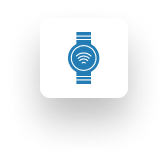Digital Patient Engagement - The Ultimate Guide

INTRODUCTION
Patient engagement refers to a situation in healthcare where patients are well-informed about and motivated to participate in their own medical care.
Patients are informed of all treatment, medication, and recovery options available to them as well as other non-clinical and administrative elements of the healthcare system that support their care.
Although patient experience and engagement are related, they are distinct concepts that must be understood. However, patient engagement is important in creating a positive patient experience. Engaged patients are more likely to feel a stronger connection to their healthcare provider, contributing to increased patient satisfaction and a better overall experience.
In this article, we’ll go over digital patient engagement in-depth, and why it is important and beneficial to care providers and other stakeholders. Also, we will cover the existing challenges in its implementation and possible strategies to overcome, and much more.
What is Digital Patient Engagement
Digital patient engagement is a digital experience that supports the patient’s ability to participate actively in their care by providing access to records, information, and communication tools. The services can include scheduling, appointments, check-ins, general communication with the staff, billing, reviews, surveys, request management during admissions, and ongoing services and information to facilitate their well-being. Digital patient engagement can involve the use of a wide variety of digital technologies, including wearables, mobile devices, mobile applications, patient portals, self-service kiosks and more.
The Objectives of Digital Patient Engagement

To enhance quality, safety, and effectiveness through coordination and communication.
Often, patients are not able to bring along their past healthcare records with them. Also, with passing time and fading memory, errors may creep in while creating new records, ultimately harming the patient in the end. A possible solution to this problem is to provide patients as well as providers with a unified and integrated cloud-based storage for all patient records that can be fetched anytime and anywhere. Interoperability can provide added value to this.

To better engage patients and families in their healthcare.
Of all the patient health-related data, patient feedback and answers have a significant ability to engage patients and improve their experience and outcomes. Online questionnaires and feedback forms are very useful digital tools for collating patient input in a very organized way, and they can also be used for a variety of use cases.

To improve outcomes while minimizing healthcare costs.
Digital and virtual care not only improves patient access and addresses health equity but also lowers healthcare implementation costs. As per a study by CDC, engaging patients through health literacy ensures better outcomes, including significantly lower healthcare costs. One more way, DPE can lower healthcare costs is by streamlining the entire administrative and staff workflow and processes. Appointment reminders, online check-in, SMS messaging, and automated rescheduling help reduce no-shows and improve doctor yield.

To establish trust by providing sufficient security and privacy.
When it comes to patient-provider relationships, trust becomes the cornerstone. Any digital platform for patient engagement must comply with data security protocols.
The Objectives of Digital Patient Engagement

To enhance quality, safety, and effectiveness through coordination and communication.

To better engage patients and families in their healthcare.
Often, patients are not able to bring along their past healthcare records with them. Also, with passing time and fading memory, errors may creep in while creating new records, ultimately harming the patient in the end. A possible solution to this problem is to provide patients as well as providers with a unified and integrated cloud-based storage for all patient records that can be fetched anytime and anywhere. Interoperability can provide added value to this.
Of all the patient health-related data, patient feedback and answers have a significant ability to engage patients and improve their experience and outcomes. Online questionnaires and feedback forms are very useful digital tools for collating patient input in a very organized way, and they can also be used for a variety of use cases.

To improve outcomes while minimizing healthcare costs.

To establish trust by providing sufficient security and privacy.
Digital and virtual care not only improves patient access and addresses health equity but also lowers healthcare implementation costs. As per a study by CDC, engaging patients through health literacy ensures better outcomes, including significantly lower healthcare costs. One more way, DPE can lower healthcare costs is by streamlining the entire administrative and staff workflow and processes. Appointment reminders, online check-in, SMS messaging, and automated rescheduling help reduce no-shows and improve doctor yield.
When it comes to patient-provider relationships, trust becomes the cornerstone. Any digital platform for patient engagement must comply with data security protocols.
Gaps And Challenges In Digital Patient Engagement
Despite the potential benefits that may result from digital patient engagement initiatives, it is a challenging area to implement, especially in healthcare organizations. There are many difficulties that can hinder the successful implementation of digital patient engagement. Gaps and challenges in digital patient engagement include:

The need to standardize data across all systems

The need for a complete and accurate understanding of the user’s needs

Having access to a database that has been built for the purpose of managing patient data in a secure environment

Having access to technology that is able to support the implementation of digital patient engagement strategies

Lack of understanding about how to implement digital patient engagement initiatives

Difficulty finding time to implement new programs

Lack of support from management and staff

Lack of financial incentives for participation
Importance And Role Of Digital Health In Improving Patient Engagement
A number of studies, according to the CDC, indicate that patients who are more actively involved and engaged in their care are more likely to experience positive health outcomes. By understanding the patient’s perspective, healthcare providers are better able to impart information to them in a way that enhances their understanding of their illness and treatment options. It also fosters trust and develops lasting positive relationships not only with the patient but also with their support system and community.
Care providers can effectively connect and communicate with patients using digital health in a way that is catered to their preferences. Additionally, these tools support the monitoring and treatment of a variety of conditions in a way that is typically less invasive and gives the patient more control. This kind of treatment is frequently referred to as “patient-centric care.”
Digital health technologies not only enhance the patient experience but also increase access to healthcare for underserved populations. For instance, these tools can enable remote access to patients who reside in remote areas that are difficult to reach or far from doctors’ offices, ensuring they continue to receive high-quality care.
Other factors besides location may exist making it difficult to get access to quality healthcare. When creating technologies to guarantee that all populations have uniform access to health information, it is essential to take into account factors such as a patient’s age, ethnicity, language, socioeconomic status, and gender, to name a few. As another illustration, a 2020 Accenture report found that younger patients were more receptive to virtual care than conventional in-person care. The report polled over 2,000 consumers across several countries.
What Makes Digital Patient Engagement The Future Of Healthcare?
It was a challenge to engage patients in healthcare in the past because everything had to be done in person, including receiving care and making payments. This pattern has been flipped upside down by technology. Patients are no longer required to be present or to be anywhere for most things, for that matter. With the proliferation of mobile devices and easy access to the internet, consumer industries quickly adapted to increase their reach and provide customers with round-the-clock access to the services and goods they provide. These gains are now being leveraged by the healthcare industry to speed up patient communication, lessen manual work, and keep patients better informed about their care. Healthcare leaders are also paying more attention to changing patient expectations and searching for scalable ways to meet them.
What are the Best Practices for digital patient engagement?
In order to ensure compliance and oversight, there are a number of factors to take into account depending on where the digital solution is being deployed. However, there are four universal factors to keep in mind before designing and implementing any digital engagement solution, regardless of location.
Patient-friendly Design
One of the most cardinal rules in designing a successful digital patient engagement tool is to keep the patient in mind. The more user-friendly it is, the higher the chances of it being adopted.
The effectiveness and long-term use of any patient engagement solution depend on an understanding of the local market, existing workflows and technology solutions, patient preferences, and current pain points.
Omni-channel Communication
It is crucial to understand and cater to how your patients prefer to consume digital health tools. While one patient may like to be updated via e-mail, another may prefer engaging on social media. Make sure that the information you share with patients is consistent, no matter where it is accessed.
Personalized And Tailor Made Care
The information imparted through various digital patient engagement tools must be personalized with multilingual support to ensure improved health literacy, a wider group of patients is engaged and empower the masses to take control of their well-being.
Inclusion, Equity, And Diversity
When developing or adopting a digital health tool, it is also important to consider diversity in backgrounds too. You must test your technology not only for its usability but also for its accessibility. Only 25 of the digital health technologies in one study met the inclusion criteria, according to a literature review of 5,968 sources from five databases. If you want to make sure that your digital health tool is accessible to everyone, regardless of race, capabilities, location, language spoken, age, etc., you must consider text size, fonts, colors, ease of use, guidelines, and regulations as important criteria.
Digital Patient Engagement Tools

Wearables
Health-based wearables are the most widely accepted patient engagement tools. They provide doctors and health professionals with the ability to track a patient’s progress and maintain constant communication. The device stores the data either locally or on the cloud to be shared with providers. This new digital tool helps in increasing patient engagement by providing them with the opportunity to monitor their own health as well as making it easier for them to take care of themselves and stay healthy. The data from wearables can also be used by healthcare providers to provide better care.

Telehealth
Telehealth and virtual care have emerged as the most important patient outreach and engagement tool, post-pandemic, allowing patients and caregivers to connect irrespective of location. Virtual visits have improved patient access and patient satisfaction for millions. Patients with debilitating chronic conditions, such as diabetes, heart disease, or cancer, who may not be able to visit health centers and clinics as frequently as is necessary to be evaluated by their healthcare provider, can easily access specialists thanks to patient engagement tools like real-time video conferencing. These tools are especially practical for people suffering from addiction or other mental health issues who may have trouble leaving the house.

Patient Portals
A patient portal is a safe online platform that provides patients with 24/7, easy access to their electronic health records from any location with an internet connection. Patients have access to health information including recent doctor visits, discharge summaries, medication regimens, immunization records, allergy details, and lab results. A patient portal also enables them to securely message their doctor, ask for prescription refills, book non-urgent appointments, check insurance benefits and coverage, update their contact information, pay bills, and read educational materials.

Tailor-made Apps
Using apps is commonplace now. Hospitals can design their own and use it as a way for clients to communicate with staff, from asking questions to responding to appointment reminders. Hospitals can also use ready-made, SaaS-based solutions for different use cases right from booking appointments, collecting patient feedback, or improving the engagement of admitted patients.

E-mail Notifications
Remember to ask new patients for their email addresses when enrolling them so you can send them timely communications. You could inform them about a new treatment that is being offered or make them aware of a medical issue that is becoming more prevalent aside from reminders about appointments or upcoming vaccinations. You can also share emails about wellness tips related to their condition.

Newsletters
A digital newsletter can be another means to engage with your patients. The benefit of a digital newsletter is that you can detect when they open it and learn if they forwarded it to a friend. Newsletters can be used to announce important news, remind patients about upcoming check-ups, share general wellness tips, special promotional offers, etc.

Surveys and Feedback
It is helpful to periodically ask patients to grade the services they are getting. Digital polls and surveys can help you gather data that can facilitate further improvements.

Social Media Communication
As part of the 360-degree omnichannel communication system, various social media platforms can be leveraged to monitor praise and criticism from patients and then act accordingly.

Follow-Up
Automated processes to contact patients after each visit is another fruitful way to increase patient engagement. Asking them if they need follow-up visits, encouraging them to rate their experience, and thanking them for their latest visit can all be part of follow-ups.
Conclusion
The objective of Digital Patient Engagement is to support the transition from treatment to prevention and self-management, helping patients live healthier lives. At the same time, it is focused on lowering costs by facilitating shared decision-making while monitoring key health indicators. And with the advent of new digital healthcare business models, it also helps healthcare providers remain relevant throughout the care journey, and not just at point-of-care.
With the rapid adoption of digital tools by patients, more research being conducted on digital health, and newer innovations within this space, it’s only a matter of time before digital patient engagement becomes a routine phenomenon in healthcare.
The Objectives of Digital Patient Engagement

To enhance quality, safety, and effectiveness through coordination and communication.
Often, patients are not able to bring along their past healthcare records with them. Also, with passing time and fading memory, errors may creep in while creating new records, ultimately harming the patient in the end. A possible solution to this problem is to provide patients as well as providers with a unified and integrated cloud-based storage for all patient records that can be fetched anytime and anywhere. Interoperability can provide added value to this.

To better engage patients and families in their healthcare.
Of all the patient health-related data, patient feedback and answers have a significant ability to engage patients and improve their experience and outcomes. Online questionnaires and feedback forms are very useful digital tools for collating patient input in a very organized way, and they can also be used for a variety of use cases.

To improve outcomes while minimizing healthcare costs.
Digital and virtual care not only improves patient access and addresses health equity but also lowers healthcare implementation costs. As per a study by CDC, engaging patients through health literacy ensures better outcomes, including significantly lower healthcare costs. One more way, DPE can lower healthcare costs is by streamlining the entire administrative and staff workflow and processes. Appointment reminders, online check-in, SMS messaging, and automated rescheduling help reduce no-shows and improve doctor yield.

To better engage patients and families in their healthcare.
When it comes to patient-provider relationships, trust becomes the cornerstone. Any digital platform for patient engagement must comply with data security protocols.




